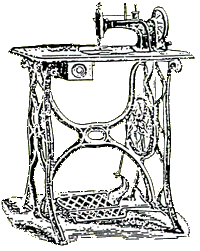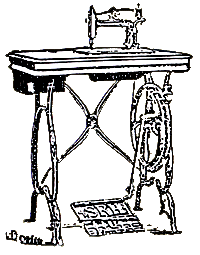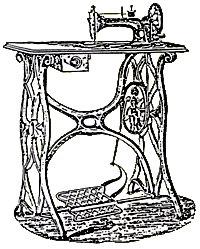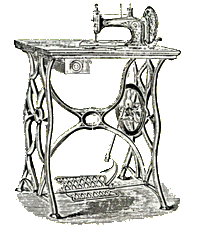In addition to
Bradbury and Company there were several other firms based in Oldham which also produced sewing machines, our research into these companies is at a very early stage but already it is clear that there is very limited information available, if you can assist us with any information on any of these firms please email us.
Watson and Company 1868 to 1884
This firm was established in 1868 by John and George Watson and manufactured sewing machines at Lee Mills, Manchester Street, Oldham.
By 1877 the firm was advertising a machine based on the Singer principle with all the latest improvements and also one on the Wheeler & Wilson principle called the Victoria Sewing Machine which, it was claimed was, "adapted to any class of work from the coarsest cloth to the finest fabric". The firm also produced a paw based machine.
The partnership dissolved in 1884 with John Watson continuing to manufacture machines.

Shepherd, Rothwell and Hough 1872 to 1890 and the Eclipse Machine Company 1890 to April 1923
The Company was formed in 1872 by Fred Rothwell, his brother Tom, Emanual Shepherd and James Edward Hough. Fred having actually been apprenticed to Bradbury & Co in 1866. They started trading from premises at Roscoe Street, Mumps before moving to Matley's Buildings, Gas Street, Oldham producing various models of the Eclipse sewing machine. The Eclipse "S" machine was based on the Singer principle and was available as both a Family and Medium machine. The Eclipse A, B, and C was a Howe principle machine with step or wheel feed.
Various patents were taken out in their names. Their patented shuttle was claimed to give the best tension and to be the easiest threaded, they also patented a feeder which was silent and adjustable, as well as a hinge, bobbin winder and a treadle stand, the latter being patented in 1876.

In 1875 the firms Trade Mark included the phrase "all other sewing machines eclipsed", by 1878 this had changed to "eclipsing all others". The firm had also moved to the Oldham Sewing Machine Works, Cromwell Street, Oldham by that date. In 1879 the firm was awarded a medal for its sewing machines by the Oldham Agricultural Society.
On 4th January 1882 the firm completed its move to Rochdale Road, Oldham but the partnership dissolved in November 1887. Fred and Tom Rothwell continued the business until the summer of 1890 by which date the firm had produced approximately 40,000 sewing machines of various types.
In 1890 the Rothwells formed the Eclipse Machine Company continuing to produce Eclipse Sewing Machines from the factory on Rochdale Road.
As well as sewing machines the Eclipse Machine Company also produced phonograph parts, bell punches and knitting machines.
In 1890 production of bicycles started and around 1897 the firm made parts for the infamous Pennington Raft-Victoria motor car.
This was followed in 1900 with the introduction of a 3 h.p. single cylinder motor cycle.
In November 1901 the Company's' first car was announced having a 6 h.p. vertical water cooled petrol engine, 3 speed gearbox with reverse with chain drive to a live rear axle. Called Rothwell cars, both 6 and 12 h.p. versions were exhibited at the Manchester Motor Show held in March 1904, these were probably powered by Aster engines. The first Rothwell to feature the firms own design of engine was a 24 h.p. car made in 1905.
In the following years a variety of engine sizes and bodies were used including Landaulet and Torpedo styles as well as a light commercial version. Production of cars ceased in 1916 and of the 500 or so built only one is known to still exist.
The company produced munitions during the First World War but closed in 1923

McDonald, Downey and Crossley to 1872
and Bromley, Downey and Crossley 1875 - 1877
The firm was a partnership between John McDonald, Hugh Downey and James Crossley producing sewing machines at Old Church Street Oldham. In 1872 McDonald left the partnership and by 1875 Downey & Crossley had been joined by Bromley.
An advertisement dating to 1875 refers to the firm producing the "celebrated" improved Oldham Domestic which appears to be a Singer principle machine and which was also available as a Medium machine suitable for tailors. A Howe principle machine was also produced, the No 1A with step feed and the No 2B, the latter was produced with either a step feed or wheel feed which was used by boot and shoemakers. The No 2B was also available with a walnut table and cover.
If you found the information provided on this website helpful why not make a donation to help support the preservation of additional machines and assist in further research? Donations can be made quickly and easily in most currancies through PayPal just click on the link below.
Sewmuse is not a charity and receives no grant aid or other such funding.
Important Copyright Notice
If you would like to use any of the material contained in the Sewmuse website please use the contact button at the top of the page.
ALL material on this web page is the copyright of David Best. All rights are reserved. No part of this web page shall be reproduced in any form without prior written permission.
ebayers please note your auctions WILL be terminated if you breach the copyright.



